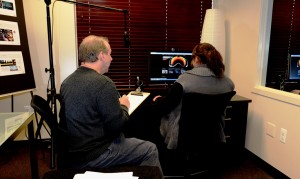 Designing successful products depends on knowing about users’ behavior as well as their preferences. What people say they do with products is not always what they actually do. The basic premise of usability testing is that we can gain unique insights into target users’ needs and preferences by observing their behavior.
Designing successful products depends on knowing about users’ behavior as well as their preferences. What people say they do with products is not always what they actually do. The basic premise of usability testing is that we can gain unique insights into target users’ needs and preferences by observing their behavior.
In lab usability testing, individual participants whose characteristics (or profiles) match those of the target users perform typical tasks with your product or a prototype. An experienced TecEd researcher facilitates the test sessions. We control as many conditions as we can—which is easier to do in the laboratory than in other venues—to identify usability problems and their causes. Many usability problems emerge within the first six sessions.
Benefits of Lab Usability Testing
Laboratory usability testing is traditionally what people mean when they say “usability testing.” Laboratory usability testing is useful for:
- Identifying problems to inform product design or redesign.
- Confirming or challenging assumptions made during the design process.
- Collecting quantitative data—for example, how long it takes users to complete a task and the number, type, and severity of errors they make. The data can be used to answer questions with measurable answers, establish performance benchmarks, or compare the usability of similar products. Laboratory usability testing is especially suited to performance testing because we can better control the test environment.
- Evaluating proprietary applications or prototypes that cannot be accessed outside the organization.
- Building credibility for usability activities within an organization. Watching people having problems in a test session is more convincing to product designers and developers than simply hearing the opinions of usability specialists.
Lab Usability Options
Test sessions can take place in TecEd’s Midwest usability lab, your company’s lab, or a rented facility. No in-house lab? With TecEd’s portable labs, all you need is a spare office or conference room. You can observe sessions in person or, in many cases, remotely via online meeting tools. You can also watch digital recordings of the sessions at your convenience.
Lab Usability Testing Process
Working closely with you, TecEd:
- Prioritizes the issues to explore, develops the criteria that indicate problems or success, designs task scenarios to focus on the most important issues to explore in the allotted time, and identifies the desired characteristics of the participants.
- Creates the test protocol, including facilitator’s script, note-taking forms, handouts, and questionnaires.
- Recruits the participants
- Conducts a pilot test and then the test sessions, typically collecting both behavioral and preference data with qualitative and quantitative components.
- Analyzes the data, develops findings and actionable recommendations for meeting users’ needs, and shares the results through debriefings, presentations, topline and detailed reports, and video highlights as appropriate.
This process also applies to usability testing conducted in users’ homes or workplaces and over the Internet.

